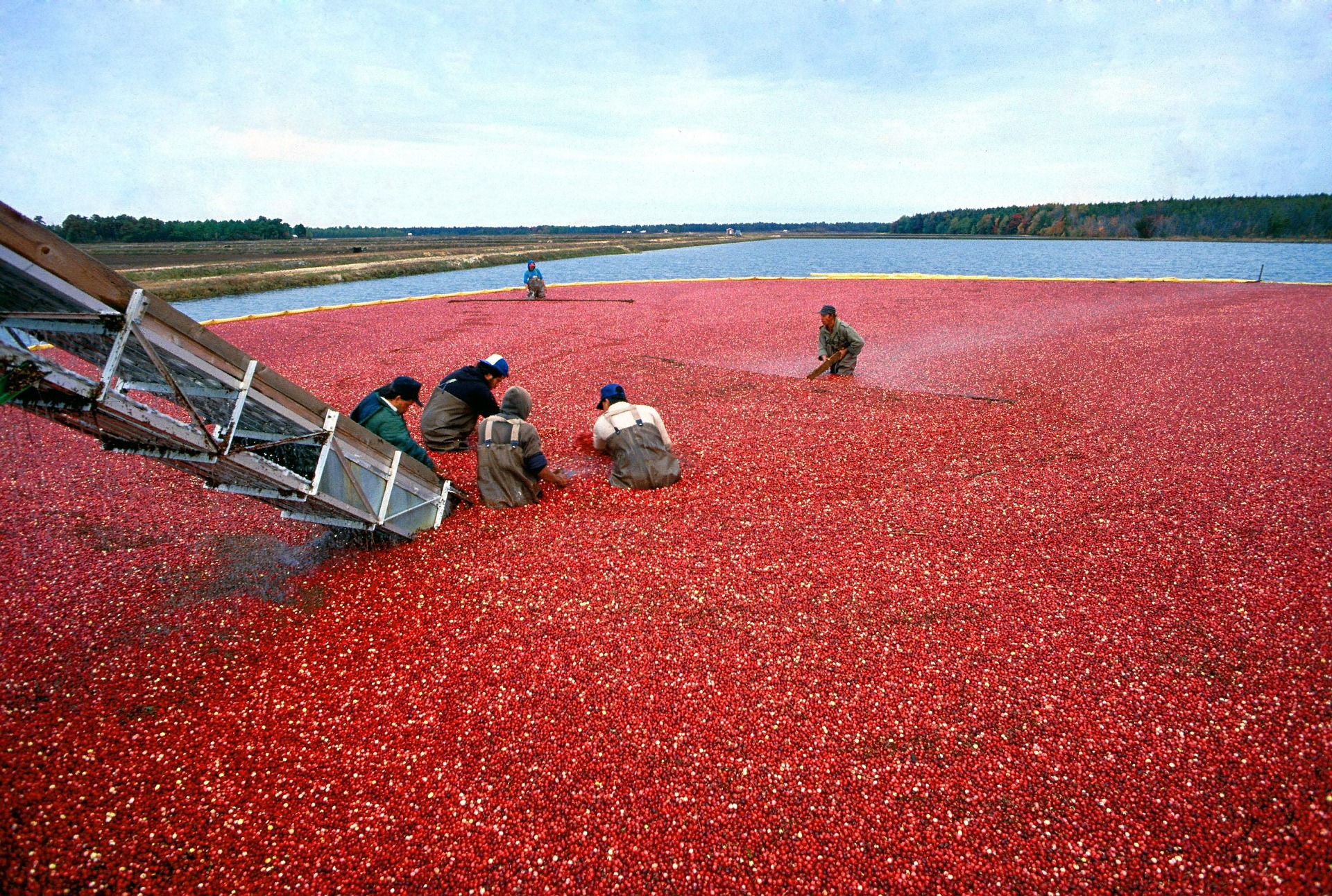When I was younger, my family took a brief autumn road trip to northern Wisconsin. One of the stops we made was a cranberry farm at harvest time. Harvesting cranberries
Before that trip, the only thing I knew about cranberries was that I needed to have at least a small portion of cranberry sauce on my plate at Thanksgiving. After all, that’s what everyone else in the family was doing, so I somehow understood this to be an important part of the holiday tradition. I thought, “That’s a lot of spoonfuls of cranberry sauce. There must be a lot of kids whose families do the same thing.” Amazing how our limited personal experience influences the way we understand the world. Little did I know how hard the cranberry salespeople were working to actually create demand for cranberries year-round.
I need to give credit to my source for the transition here. Quoting the comedian Brian Regan:
“I don’t know what’s going on with cranberries, but they’re getting in all the other juices. Whoever the salesman is for cranberries does a great job. He’s showing up everywhere. ‘Hey, what do you got, apples? Put some cranberries in there. We’ll call it cran-apple, go 50-50. What do you got, grapes? How about cran-grape. What do you got, mangoes? Cran-mango. What do you got, pork chops? Cran-chops.’ Why don’t you back off, cran-man. Why don’t you take your sales trophy and have a vacation? He’s working too hard.”
Work smarter, not harder
It’s a great punchline, but I’m going to refute it for the sake of making a point: Cran-man isn’t working hard — he’s working smart. He’s figured out how to create some winning partnerships that ensure strong revenue for his fruit beyond the family dinner table. The guy is on to something. In fact, I have a theory that he did so well with the combos that he amassed a whole case of Cranberry Sales and Strategic Partnership and Creative Marketing trophies. And then, instead of a vacation, he switched industries — and now he sells poodles.
You already know where I’m going . . . “I don’t know what’s going on with poodles, but they’re getting with all the other dogs. Whoever the salesman is for poodles does a great job. He’s showing up everywhere. ‘Hey, what do you got, labradors? Put ’em with some poodles. We’ll call them Labradoodles, go 50-50. What do you got, golden retrievers? How about Goldendoodles. What do you got, schnauzers? Schnoodles. What do you got, cats? Catoodles.'” Hey, Cran-Doodle-Man: when you’re done with the Bernese Mountain Dog guy, give us a call. I want to talk with you about a career opportunity.
Lessons from the Cran-Doodle Salesman
It’s more than just hustle that makes the Cran-Doodle Salesman successful. He knows a few things about building mutually beneficial partnerships with his collaborators.
- He knows his product(s)
- He knows his target market
- He’s identified what makes cranberries an attractive juice option (see: features & benefits).
- He’s also done his research on the other juices, and instead of seeing competitors, he sees collaborators.
Cranberry sales were down, and Cran-man was getting worried. Boss is coming to him and saying, ‘Listen, Ed, you gotta improve sales in the second quarter. No one’s buying cranberry sauce after December. Figure it out.’ So now he’s sweating, can’t sleep, wakes up in a panic: ‘No one eats cranberry sauce in spring, the weather’s too warm. But they are drinking juice… lots of juice… lots of kinds of juice… apple juice and grape juice and pineapple juice… How am I ever going to compete with that variety? How can I possibly sell as much cranberry juice as all of the other juices?
And you know Ed’s friends on the sales team are giving him a hard time. “That’s never going to work. You’re telling us that you’re going to walk into Mr. Macintosh’s office out in Washington and tell him his apple juice isn’t good enough without cranberries? Forget it!”
But Ed knows what his product can do, why people like it, and also why they don’t. And he knows why people are buying apple juice and grape juice and mango juice, and he sees the possibilities. It’s the ultimate “if you can’t beat ’em, join ’em” play. And it works.
Ed’s company doesn’t make apple juice; Mr. Macintosh’s company doesn’t make cranberry juice. But Cran-man has done his research, and he knows there are consumers who would like a juice that’s both sweet and tart, with the fiber of apples and the antioxidants of cranberries. With Cran-Apple juice, Ed doubles the sales of cranberries, and the rest is history. (Just for fun, I looked it up: Ocean Spray now sells more than a dozen different cran-fruit juice blends.)
When your behaviors bring success, do them again
So when Cran-man’s trophy case fills up and he goes looking for a new challenge, he repeats the winning formula as Doodle-man.
Do you want to experience the same kind of successful collaborations that the cran-doodle man has experienced? Here are some things to think through as you look for a good strategic partner for your efforts:
- Why do your current users choose your product or brand over the competition?
- What do you do that your competitors don’t?
- What kind of users are attracted by that feature?
- Why do your competitor’s users choose their product or brand over yours?
- What do your competitors do that you don’t?
- What kind of users are attracted by that feature?
- How could you “blend” the two products or brands together?
- What is your differentiator? At what single thing are YOU the best?
- What is their differentiator? At what single thing are THEY the best?
- Are those two things the same?
- Or are they two different aspects of something bigger or broader?
- Are there users who would choose that bigger or broader product with the multiple features, if given the choice?
Let’s see what that strategic analysis looks like for the infamous labradoodle. Why do families choose poodles? What is your differentiator? Poodles are known for being intelligent and for not shedding (much). Why do families choose labradors? What is their differentiator? Labradors are known for their gentle temperament and for being good disability assistance dogs. if we “blend” those two breeds together, would families choose the new hybrid model? If they are looking for an allergy friendly guide dog — then yes, they most certainly will.
Turning competitors into collaborators
SPEARity has a web-app that we use to support the business coaching and strategic planning we do for our members. Our members told us that our app was lacking a robust help menu (feature), which we agreed would significantly improve how fast new users got up-to-speed on the daily planning habit (foundational for everything we do to help businesses grow).
We could have specced out the solution ourselves, and had developers code it into our proprietary app, and created an amazing new feature that our users would love! But, that would have taken a lot of time, incurred a significant investment, and possibly have created some headaches and unexpected complications.
Or, we could have looked for an existing help menu tool that was plug and play (or from a coding perspective copy and paste ready). It wouldn’t have been custom built just for us, so it wouldn’t be perfect and have the exact specs we imagined. But, it would have been tested and proven by someone else, and ready to deploy much faster.
We faced the common question of every designer and product manager: Form (get: high quality; give up: speed and investment), ), or Function (get: cost savings, speed to market; give up: perfect fit)?
Like the Master Collaborator (our mentor, the Cran-Doodle salesman), we chose Function. Twice. First for the pop-up “welcome wizard” that takes new users through the app basics in 5 clicks (just like every well-designed app you’ve ever downloaded to your device), and then for the “ask a question” live-chat help feature. The welcome wizard was open-source JavaScript that our developers added into the web app, and the live-chat is an integration from Zendesk. One bird, two stones, and neither came from our own backyard.
Putting it into play in your organization
Designers who work smarter spend more time on the front end understanding the user’s true needs than do designers who work harder on the back end designing and redesigning their solution until it’s just right.
Savvy collaborators understand that the best solutions often already exist, and are rarely “invented here.” If you’ve ever Googled the answer to a question, you’re engaging in that search from your belief that someone else has already figured this out. These are the mindsets that collaboration is all about.
So, how does all this apply to your business?
- Is there an area where your business could be improving but you’ve refused to work with others in the process?
- Are the departments within your organization working as silos when the entire organization could benefit from a little collaboration?
- Could a organizational process become more efficient for you, your employees, and/or your customers if you collaborated with another company?
Don’t be afraid to start thinking outside of the box in order to grow your business. Look for the strategic moves that you can make for the benefit of the company. Who can you align with and collaborate with that will have a mutual benefit for both parties? And as you’re trying to figure this out, remember that strategic partners are more than just complementary businesses; sometimes they’re actually collaborating frenemies.
Are you interested in growing your business with collaboration? Need help? Let’s talk! We are SPEARity, a local Milwaukee leadership coaching firm that specializes in business coaching, executive coaching, and leadership development training.







